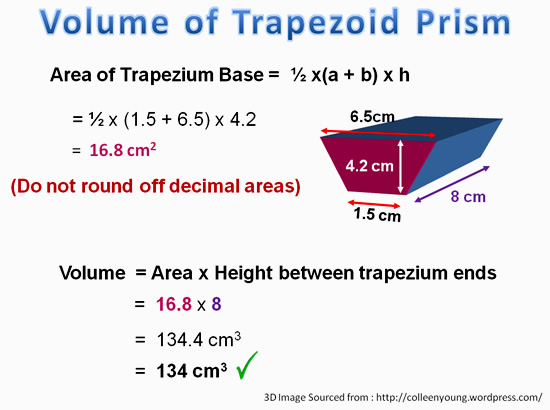

Like all three-dimensional shapes, you will learn how to calculate the surface area of a trapezoidal prism.

Not all planes of reflection are also planes of symmetry. As Leo paints the stand, he calculates the surface area of the stand to be 35 ft2. The base of the prism has an area of 3 ft2, and the prism stands 3.2 feet high. The stand is in the shape of a right trapezoidal prism. Kern, James R Bland,Solid Mensuration with proofs, 1938, p.81' for the name truncated prism, but I cannot find this book. A trapezoidal prism is a three-dimensional solid that is made up of two trapezoids on opposite faces which are joined by four rectangles called the lateral faces. Slicing a round orange with a knife into two equal halves creates a plane of symmetry of the orange. Leo designs a stand for the new statue on display at the local library. (I integrated the area of the horizontal cross-sections after passing the first intersection with the hyperplane at height $h_1$ these cross-sections have the form of the base triangle minus a quadratically increasing triangle, then after crossing the first intersection at height $h_2$ they have the form of a quadratically shrinking triangle)ĭo you know of an elegant proof of the volume formula? I was also able to prove this formula myself, but with a really nasty proof. (where $A$ is the area of the triangle base) online, but without proof. The 3D figure of a trapezoid is called a trapezoidal prism since these are figures that have a length, width, and depth. The edges of the prism is where the faces meet, and the vertices of the prism are the corners where three or more surfaces meet.I needed to find the volume of what Wikipedia calls a truncated prism, which is a prism (with triangle base) that is intersected with a halfspace such that the boundary of the halfspace intersects the three vertical edges of the prism at heights $h_1, h_2, h_3$.

Where A is the area, h is the height, a and b are the lengths of the base trapezoids Why is the Trapezoidal Prism a 3D Figure? Since the prism has two trapezoids, to calculate the volume we need to find the height of one of the trapezoids using this formula: In order to find the height of a trapezoidal prism, we need to find the area of one of the trapezoids. So a trapezoidal prism has a total of 6 faces, 12 edges, and 8 vertices. Therefore, the side faces are rectangles. Area basis1 + basis2 2 height length Basis Bottom Basis Top Height Length Calculate Reset Details: A a + b 2 h l Rate this calculator: 4. (Technically, when the sides are rectangles, the shape is known as a right prism, indicating that the lateral faces meet the sides of the base at right angles. How do you Find the Height of a Trapezoidal Prism? In general, a trapezoidal prism means a right trapezoidal prism. A right triangular prism has rectangular sides, otherwise it is oblique. A prism is a polyhedron for which the top and bottom faces (known as the bases) are congruent polygons, and all other faces (known as the lateral faces) are rectangles. The two legs of the trapezoid are labeled 10 cm. Example 3: Figure 6 is an isosceles trapezoidal right prism. The larger base is labeled 15 cm and the shorter base is labeled 5 cm. Theorem 89: The volume, V, of a right prism with a base area B and an altitude h is given by the following equation. When the trapezoidal prism is flattened, we can see these two images clearly. A right prism is a solid (or 3D) object with two parallel bases or ends that are identical and flat faces that are rectangles. The height of the trapezoid base is labeled 7 cm. The net of a trapezoidal prism is that it consists of two trapezoids and four rectangles.

Where h is the height, b and d are the lengths of the base, a + b + c + d is the perimeter, and l is the lateral surface area. Surface Area of a Trapezoidal Prism = h (b + d) + l (a + b + c + d) The formula to calculate the surface area of a trapezoidal prism is: Where h is the height of trapezoidal, l is the height of the prism, a and b are the lengths of the top and bottom of a trapezoidal prism What is the Formula to Calculate the Surface Area of a Trapezoidal Prism? The formula to calculate the volume of a trapezoidal prism is:Īrea (A) = ½ × h × (a + b) or ½ h(b 1+ b 2) To find the volume of a trapezoidal prism, we need to first find the area of one trapezoid. What is the Formula to Calculate the Volume of a Trapezoidal Prism? One of the box noticeable example of a trapezoidal prism that we see in daily life is fire brick. A trapezoidal prism was given its name since it is made up of trapezoids. A trapezoidal prism has six faces, eight vertices, and 12 edges. FAQs on Trapezoidal Prism What is a Trapezoidal Prism?Ī trapezoidal prism is a 3D shape with two trapezoids as its base that is being joined by four rectangles.


 0 kommentar(er)
0 kommentar(er)
